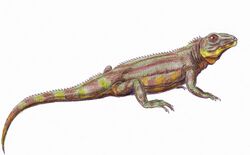Biology:Bolosauridae
| Bolosauridae | |
|---|---|

| |
| Life restoration of Belebey vegrandis | |
| Scientific classification | |
| Domain: | Eukaryota |
| Kingdom: | Animalia |
| Phylum: | Chordata |
| Class: | Reptilia |
| Clade: | †Parareptilia |
| Order: | †Procolophonomorpha |
| Node: | †Procolophoniformes |
| Family: | †Bolosauridae Cope, 1878 |
Bolosauridae is an extinct family of ankyramorph parareptiles known from the latest Carboniferous (Gzhelian) or earliest Permian (Asselian) to the early Guadalupian epoch (latest Roadian stage) of North America, China , Germany , Russia and France .[1][2] The bolosaurids were unusual for their time period by being bipedal, the oldest known tetrapods to have been so. Their teeth suggest that they were herbivores. The bolosaurids were a rare group and died out without any known descendants. The following cladogram shows the phylogenetic position of the Bolosauridae, from Johannes Müller, Jin-Ling Li and Robert R. Reisz, 2008.[3]
| Bolosauridae |
| |||||||||||||||||||||||||||
References
- ↑ Marcello Ruta; Juan C. Cisneros; Torsten Liebrect; Linda A. Tsuji; Johannes Muller (2011). "Amniotes through major biological crises: faunal turnover among Parareptiles and the end-Permian mass extinction". Palaeontology 54 (5): 1117–1137. doi:10.1111/j.1475-4983.2011.01051.x.
- ↑ Jocelyn Falconnet (2012). "First evidence of a bolosaurid parareptile in France (latest Carboniferous-earliest Permian of the Autun basin) and the spatiotemporal distribution of the Bolosauridae". Bulletin de la Société Géologique de France 183 (6): 495–508. doi:10.2113/gssgfbull.183.6.495. http://bsgf.geoscienceworld.org/content/183/6/495.abstract.
- ↑ Johannes Müller; Jin-Ling Li; Robert R. Reisz (2008). "A new bolosaurid parareptile, Belebey chengi sp. nov., from the Middle Permian of China and its paleogeographic significance". Naturwissenschaften 95 (12): 1169–1174. doi:10.1007/s00114-008-0438-0. PMID 18726080.
Wikidata ☰ Q140372 entry
 |

